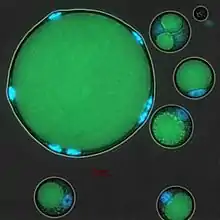Abeoforma whisleri
Abeoforma whisleri is a single-celled eukaryote that belongs to the Ichthyosporea clade, a group of protists closely related to animals.
| Abeoforma whisleri | |
|---|---|
 | |
| Scientific classification | |
| Domain: | |
| (unranked): | |
| (unranked): | |
| Class: | |
| Order: | |
| Genus: | Abeoforma |
| Species: | A. whisleri |
| Binomial name | |
| Abeoforma whisleri Marshall, 2008 | |
Taxonomy
A. whisleri is a member of the Ichthyosporea clade, within the Teretosporea, which is the earliest branching holozoan lineage.[1][2] A. whisleri was isolated from the digestive tract of the filter-feeding mussel Mytilus sp in 2011; its discovery was reported alongside Pirum gemmata.[3]
SSU-rDNA sequence analysis of A. whisleri found a genome 1674 nucleotides in length, with a 95.7% similarity to Pirum gemmata. Analysis of this SSU-rDNA sequence also found a 90% similarity with sequences found in Amoebidium parasiticum, Sphaeroforma arctica, and Creolimax fragrantissima.[3]
Life Cycle
A. whisleri has a very complex life-cycle, yet to be resolved. It includes several different cell stages, ranging from amoeboidal, hyphal-like and plasmodial stages, which can present filopodia-like (pseudopodia) structures. They also present coenocytic spherical stages with prominent vacuoles and several nuclei. All of those stages undergo dramatic morphological changes and have a cell wall (except for the amoeboid stage).
Applications

A. whisleri can easily be cultured axenically in marine broth medium. Given its phylogenetic position as a close unicellular relative of animals and its high capacity to modify cell morphology, A. whisleri could potentially provide important insights both into the origin of multicellular animals and into the control of cell shape in eukaryotes.
References
- Glockling, Sally L.; Marshall, Wyth L.; Gleason, Frank H. (2013-08-01). "Phylogenetic interpretations and ecological potentials of the Mesomycetozoea (Ichthyosporea)". Fungal Ecology. 6 (4): 237–247. doi:10.1016/j.funeco.2013.03.005.
- Torruella, Guifré; Mendoza, Alex de; Grau-Bové, Xavier; Antó, Meritxell; Chaplin, Mark A.; Campo, Javier del; Eme, Laura; Pérez-Cordón, Gregorio; Whipps, Christopher M. (2015). "Phylogenomics Reveals Convergent Evolution of Lifestyles in Close Relatives of Animals and Fungi". Current Biology. 25 (18): 2404–2410. doi:10.1016/j.cub.2015.07.053. PMID 26365255.
- Marshall, Wyth L.; Berbee, Mary L. (2011-01-01). "Facing Unknowns: Living Cultures (Pirum gemmata gen. nov., sp. nov., and Abeoforma whisleri, gen. nov., sp. nov.) from Invertebrate Digestive Tracts Represent an Undescribed Clade within the Unicellular Opisthokont Lineage Ichthyosporea (Mesomycetozoea)". Protist. 162 (1): 33–57. doi:10.1016/j.protis.2010.06.002. PMID 20708961.